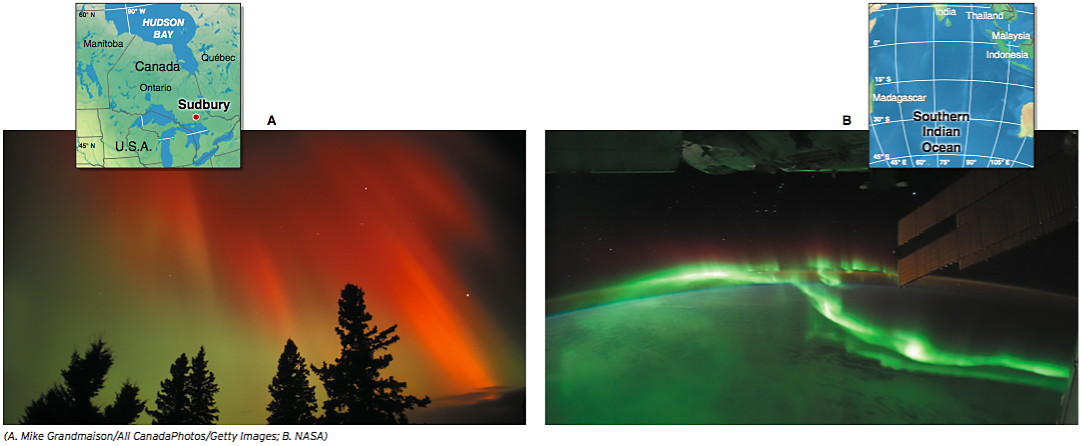1.3 The Layered Atmosphere
Name and describe the atmosphere’s layers.
As we will see throughout this book, many of Earth’s physical systems are composed of layers. In the lithosphere, layers make up Earth’s internal structure. In the hydrosphere, the oceans have layers distinguished by light penetration, temperature, and life. In tropical rainforests, vegetation forms many different canopy and understory layers.
The atmosphere, too, is structured in layers. The homosphere and the heterosphere layers of the atmosphere can be distinguished based on concentrations of gases. These layers, however, play a minor role in Earth’s physical systems. Layers based on changing trends in temperature with altitude, however, have important effects on Earth’s physical systems.
Layers Based on Temperature
You may be familiar with the way the temperature of the atmosphere changes with altitude. If you have ever been high in the mountains, you probably noticed that the air is cooler there than at lower elevations. But if you kept climbing higher in the atmosphere, you might be surprised to find that high above the highest mountains, the atmosphere gets warmer again.
|
LAYER |
ALTITUDE (KM) |
ALTITUDE (MI) |
MAJOR FEATURES |
|---|---|---|---|
|
Thermosphere |
80– |
50– |
Auroras (northern and southern lights) occur here |
|
Mesosphere |
50– |
30– |
Meteors burn up here |
|
Stratosphere |
12– |
7.5– |
Ozone gas absorbs harmful solar rays here |
|
Troposphere |
0– |
0– |
All weather occurs here |
There are four main thermal divisions of the atmosphere based on changes in temperature with altitude: The troposphere extends from Earth’s surface up to about 12 km (7.5 mi), on average. It is the lowest layer of the atmosphere, in which all weather occurs. The next layer up, the stratosphere, is found between 12 and 50 km (7.5 and 30 mi) above Earth’s surface. The stratosphere contains a permanent temperature inversion because it is heated as it absorbs radiation from the Sun. A temperature inversion is a layer of the atmosphere in which air temperature increases with increased height (see also Section 1.4). Above the stratosphere, the mesosphere lies between 50 and 80 km (30 and 50 mi) above Earth’s surface. The thermosphere is located from 80 to 600 km (50 to 370 mi) above Earth’s surface. Figure 1.5 illustrates these divisions and their main characteristics.
troposphere
The lowest layer of the atmosphere, extending from Earth’s surface up to about 12 km (7.5 mi), where all weather occurs.
stratosphere
The atmospheric layer above the troposphere, which extends between about 12 and 50 km (7.5 and 30 mi) above Earth’s surface and has a permanent temperature inversion.
temperature inversion
A layer of the atmosphere in which air temperature increases with increased height.
mesosphere
The layer of the atmosphere between 50 and 80 km (30 and 50 mi) above the surface.
thermosphere
The atmospheric layer located from 80 to 600 km (50 to 370 mi) above the surface.
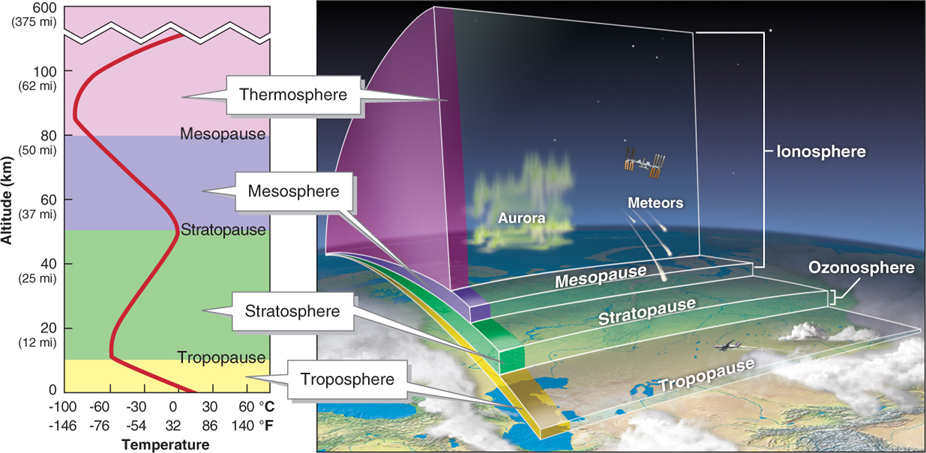
Our knowledge of the atmosphere’s structure is less than a century old. Much of what scientists know about the atmosphere comes from two main sources of information: weather balloons and orbiting satellites. The development of this knowledge is sketched in Figure 1.6.
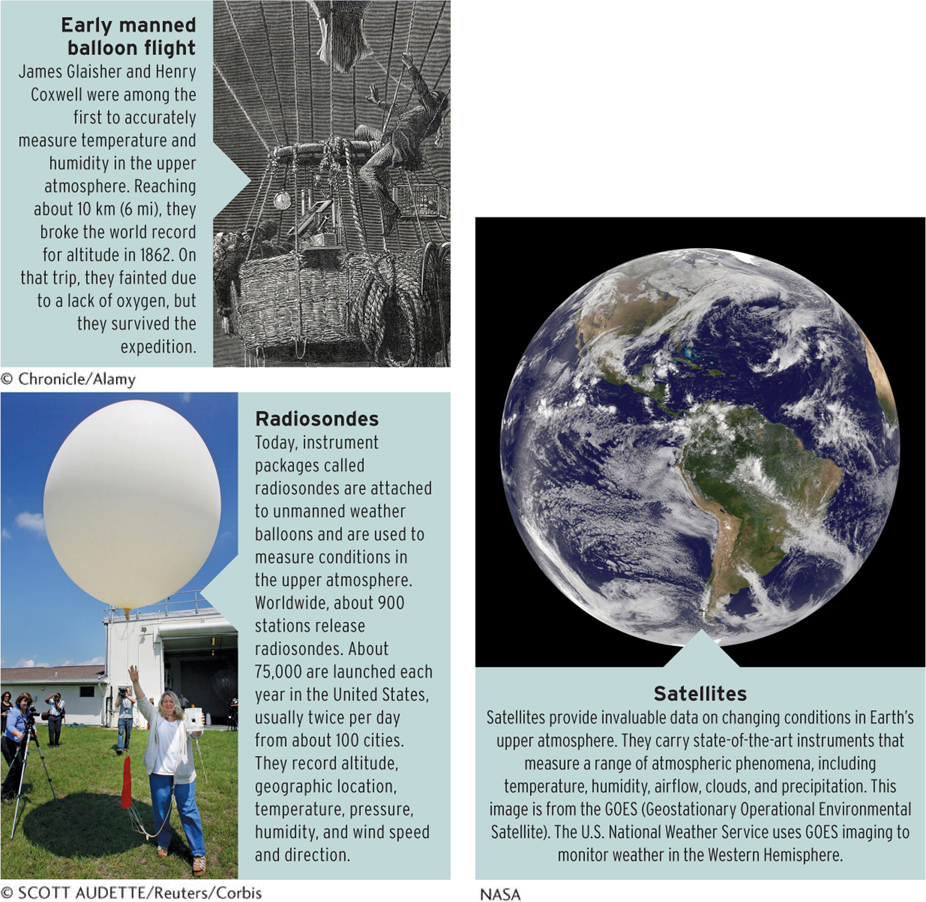
The Weather Layer: The Troposphere
The troposphere is warmed from the bottom up by Earth’s surface, which is warmed by sunlight. As one moves higher in the troposphere, air temperature generally decreases. The environmental lapse rate is the rate of cooling with increasing altitude in the troposphere. The average environmental lapse rate is 6.5°C per 1,000 m or 3.6°F per 1,000 ft. Keep in mind that this is an average rate, and that the atmosphere may cool much faster or slower, depending on the time and the location.
environmental lapse rate
The rate of cooling with increasing altitude in the troposphere. The average environmental lapse rate is 6.5°C per 1,000 m or 3.6°F per 1,000 ft.
CRUNCH THE NUMBERS: Calculating Temperature Changes
CRUNCH THE NUMBERS: Calculating Temperature Changes
Imagine you are driving from the beach (at sea level) to the top of a mountain 3,000 m (9,840 ft) tall near the coast. Calculate the temperature of the troposphere at the mountaintop using the environmental lapse rates given. Notice that the environmental lapse rate changes with each example; it can change as a result of local conditions at any given time. Steeper environmental lapse rates lead to colder temperatures at high altitudes. The first example is done for you.
|
Ground Temperature (°C) |
Environmental Lapse Rate |
Height (m) |
Temperature at This Height (°C) |
|---|---|---|---|
|
30 |
4°C/1,000 m |
3,000 |
18 |
|
Answer:The height change between sea level and the mountaintop is 3,000 m. (4°C/1,000 m) × 3,000 m = 12° of cooling. 30° − 12° = 18° |
|||
|
30 |
6.5°C/1,000 m |
3,000 |
Question 1.3 |
|
30 |
8°C/1,000 m |
3,000 |
Question 1.4 |
|
Ground Temperature (°F) |
Environmental Lapse Rate |
Height Change (ft) |
Temperature at This Height (°F) |
|---|---|---|---|
|
86 |
2.2°F/1,000 ft |
9,840 |
Question 1.5 |
|
86 |
3.6°F/1,000 ft |
9,840 |
Question 1.6 |
|
86 |
4.4°F/1,000 ft |
9,840 |
Question 1.7 |
In the Crunch the Numbers feature above, you will use the environmental lapse rate to calculate the temperature you can expect on a mountaintop.
In the lower troposphere, temperature inversions sometimes develop. There are many ways in which temperature inversions may form. They often develop in valleys, where a cold, dense mass of air may form close to the ground. Above this cold air mass, the temperature increases. Temperature inversions in the troposphere are usually no more than a few hundred meters thick, and a little higher up, the normal cooling trend resumes.
Temperature inversions in the atmosphere are significant in several ways. The temperature inversion in the stratosphere limits almost all clouds to the troposphere, as we’ll see later in this section. Temperature inversions in the troposphere can trap pollutants near the ground surface (see Section 1.4). They also can create sleet and freezing rain during winter storms.
Roughly 80% of the mass of the atmosphere is in the troposphere, and it is where Earth’s weather occurs.Almost all clouds, and all storms and precipitation, are limited to the troposphere. The troposphere experiences strong vertical mixing: The Greek word tropos means to turn over, or convect. The troposphere ends, and the stratosphere begins, at the tropopause. Almost all cloud tops end at the tropopause, where the atmosphere begins to warm due to the temperature inversion in the stratosphere. The temperature inversion prevents clouds from rising, as discussed in the Picture This feature below.
tropopause
The boundary between the troposphere and the stratosphere.
Picture This
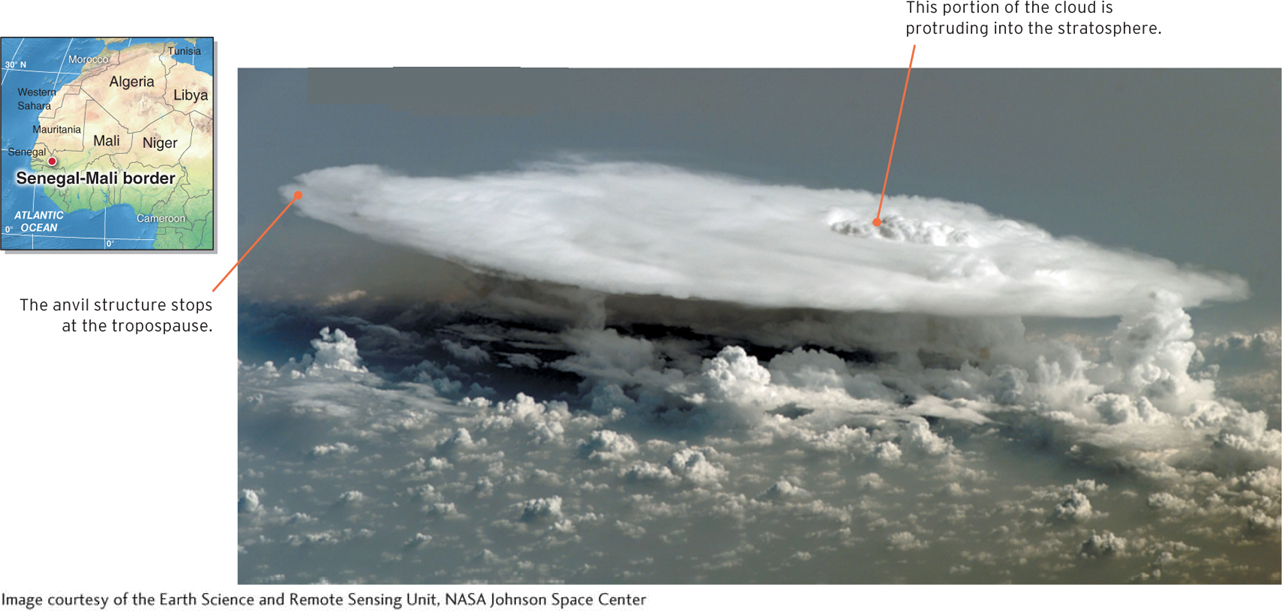
The Tropopause
This towering cumulonimbus cloud has grown from Earth’s surface up to the base of the stratosphere. Most of the cloud has not entered the stratosphere. Instead, it is splaying out horizontally at the tropopause, creating a flattened anvil structure. The cloud cannot rise into the stratosphere because the cloud’s relatively cold air is denser and heavier than the relatively warm air of the stratosphere. This photo was taken by an astronaut in the International Space Station while it was over the Senegal-
Consider This
Question 1.8
The anvil of this cumulonimbus cloud occurs at what boundary line?
Question 1.9
Given the latitude of this cloud, how high does it extend in kilometers?
Question 1.10
In the context of the relative densities of air and water, explain why a bubble of air rises in water. Relate your explanation to why this cumulonimbus cloud rises high in the troposphere and stops at the stratosphere.
As we have seen, the average height of the tropopause is about 12 km (7.5 mi). At the equator, the tropopause is 18 km (11 mi) above Earth’s surface. At midlatitudes, it is about 12 km (7.5 mi) above Earth’s surface, and in the polar regions it occurs at about 8 km (5 mi) in altitude (Figure 1.7).
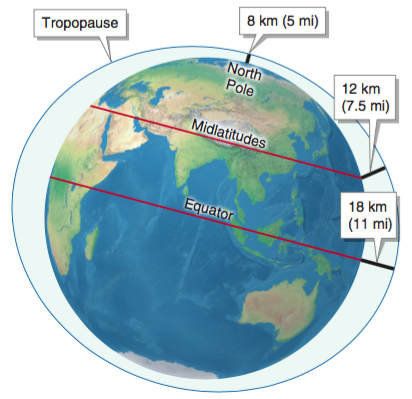
Why is the tropopause roughly twice as high over the equator as over the poles? There are two reasons. First, solar heating of the atmosphere expands air and causes it to occupy more space. Heating is greatest near the equator, in the tropics. Second, Earth rotates faster at the equator than in polar regions (see Section GT.2). Therefore, the atmosphere near the equator bulges outward more than that at higher latitudes, increasing its depth. The height of the tropopause also increases in summer and decreases in winter due to changing temperatures in the atmosphere.
A Protective Shield: The Stratosphere
Above the tropopause is the stratosphere. There are very few clouds in the stratosphere, and the air is mostly free of atmospheric aerosols. As Figure 1.8 shows, the contrast between the two layers can be vivid.

 As a result of its permanent temperature inversion, there is little vertical mixing in the stratosphere—
As a result of its permanent temperature inversion, there is little vertical mixing in the stratosphere—
ultraviolet (UV) radiation
Solar radiation that is shorter than visible wavelengths.
ozonosphere
(pronounced oh-
The Mesosphere and Thermosphere
The mesosphere lies above the stratosphere. Although air density (and pressure) in the mesosphere is extremely low, meteors (sometimes called shooting stars) heat up and vaporize as they encounter friction with the air molecules in the mesosphere. As in the troposphere, temperature decreases with height in the mesosphere, until it reaches about −90°C (−130°F) at about 85 km (53 mi) above Earth’s surface.
Above the mesopause lies the thermosphere. As in the stratosphere, there is a permanent temperature inversion in the thermosphere, caused by absorption of the Sun’s radiation by gas molecules. Temperatures in the thermosphere rise as high as 1,200°C (2,200°F). What would the thermosphere feel like to a person? The air would feel cold because it is extremely thin (air molecules are exceedingly far apart). As a result, very little heat would be transferred to your body.
The top of the thermosphere (the thermopause) is 600 km (370 mi) above Earth’s surface. Here, the air is so thin that molecules move some 10 km (6 mi), on average, before colliding with another molecule. In the troposphere, where molecular density is much greater, molecules move only a millionth of a centimeter, on average, before colliding. At the top of the thermosphere some molecules reach escape velocity, meaning that they can overcome Earth’s gravitational pull and enter the depths of space forever. The region where molecules are free of Earth’s gravity is the exosphere.
The Ionosphere: Nature’s Light Show
The last atmospheric layer we will examine, the ionosphere, is distinguished by its electrical properties. The ionosphere is a region of the upper mesosphere and the thermosphere between roughly 80 and 600 km (50 to 373 mi) in altitude where nitrogen and oxygen are ionized by solar energy. The ionosphere interacts with and absorbs UV, X-
ionosphere
A region of the upper mesosphere and the thermosphere between about 80 and 500 km (50 to 310 mi) where gases are ionized by solar energy.
Question 1.11
What are northern lights?
Northern lights result when the Sun’s energy energizes gas molecules in the ionosphere, causing them to emit light.
Nature’s most impressive light shows, the aurora borealis (northern lights) and the aurora australis (southern lights), occur in the ionosphere. Auroras are caused by energized gas molecules in the ionosphere. The molecules are energized by charged particles (called the solar wind) from the Sun, creating beautiful displays of light. The colors of the aurora depend on the types of gases that are energized by the solar wind and the altitude at which they are energized. Auroras are found mostly near the poles because that is where Earth’s magnetic field concentrates the solar wind’s particles.
aurora borealis
Displays of light (also called northern lights) caused by energized molecules in the ionosphere.
aurora australis
Displays of light (also called southern lights) caused by energized molecules in the ionosphere.
Aurora displays coincide with solar flare activity on the Sun. Although auroras are occasionally seen at latitudes as low as the southern United States, the best place to see them is at high latitudes during the dark winter months (Figure 1.9).
